| |

Read the words of Newburyport men and women who lived during the 1700s, 1800s and early 1900s.
Susan P. Currier
Susan Page Currier (1838-1910) was the wife of John J. Currier, a Newburyport historian, and daughter of a well-known Newburyport school teacher, David Perkins Page. Mrs. Currier kept diaries most of her life, many of them now in the possession of her descendant Sue Follansbee. On the last day of December 1883, Susan Currier wrote in her diary:
Portrait of Susan and John J. Currier. Courtesy of Sue Follansbee.
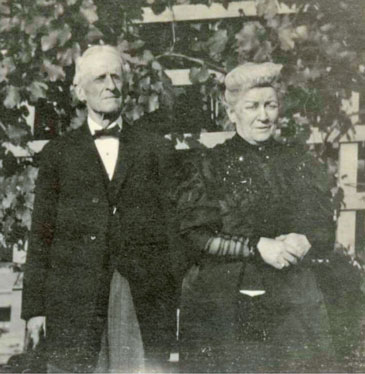 |
"I cannot realize that this is the last day of the year; that it closes my little diary which has in it so much of my own life and the loves of my friends. The year has been a peaceful and happy one, and I thought, when our rector said in his sermon yesterday, that no one, probably, would wish to live the year over again, that I would be willing to, for it has been a happy one to me. Of course, I have made mistakes and done many things I should not have done, but even with this experience I doubt if I should do any better, if allowed to live the past year over again. I have had many things to worry me, but one must expect them in this life, and if we do not look for them they will certainly come to harass and annoy us.
"I wish I could feel that I was better for the year’s experience and had done more good for, and to, others. I am thankful that we have all been spared to the close of another year, that we have had no serious sickness and no misfortunes or disasters to trouble us. How grateful we ought to be for all these favors.
"God grant that in the coming year we may improve the opportunities we have wasted in the one just going and that we may try to lead better lives; be more patient, conciliatory and kind, and all – my dear husband, children and friends – be spared to record at the close of another year our grateful sense of the goodness of God to us all."

Eben F. Stone
Honorable Eben F. Stone (1822-1895), a colonel in the Civil War, a lawyer, and a mayor of Newburyport, reflects in 1885 about the community at the 250th celebration of the settlement of Newbury:
Portrait of Eben F. Dodge. History of Newburyport, Massachusetts by John J. Currier.
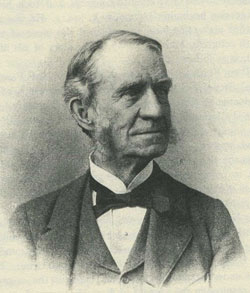 |
"There were two sets of rich men, conspicuous in Newburyport, in the days of its prosperity. The first was composed largely of men of gentlemen, who enjoyed and appreciated everything that belonged to a high civilization. They built fine residences at some distance from their wharves and warehouse, and surrounded themselves with all the comforts and refinements that wealth and education could give. Of such, were Dalton, Hooper, Tracy, Jackson, John Coffin Jones, and others. Another set, nearly contemporaneous, but a little later and more directly the product of the extraordinary prosperity that marks the history of this period, was composed of successful traders, whose lives were devoted, exclusively, to the accumulation of property, and who built fine houses, not where they could command a view of the open country, but upon the main streets, so near to their places of business that they were never out of sight of their ships and warehouses where their treasures were stored. Of such, were Bartlett, Brown, Coombs and Marquand, Pettengill, Johnson, and others. Both classes were patriotic and public spirited, but it was the first class that was specially distinguished for the revolutionary spirit which placed Newburyport among the first for unselfish devotion to the interests of the country."

|
Minnie Atkinson
At an early age, Miss Minnie Atkinson (1868-1958) developed her love of reading and writing. In the Newburyport Daily News, November 5, 1938, she reminisced about her childhood:
"I can remember coming home from church . . . and being permitted to go into the parlor that was sacred to Sunday afternoons and parties. I can smell now the heat of the newly-made fire. . . We used to sit in front of this fire and cut newspapers up into little leaves. Then with a needle and thread we would bind them into little books. Who taught us such a fascinating pursuit I cannot tell, but I remember working almost frantically at it, and all my life since I have wanted to make books."
Portrait of Minnie Atkinson. Courtesy of Mae Atkinson.
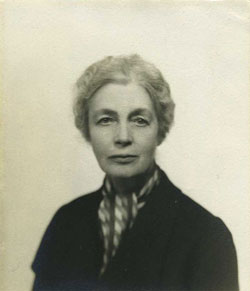 |
In later years, Miss Atkinson was very involved in the First Religious Society, Unitarian Church’s women’s groups and Study Class, a group of local women writers studying current events and world issues. She reflected on the importance of women’s groups:
"It has been my thoughts for many years that such societies, as this, indeed, that all societies devoted to good and pleasant purposes, are part of the basis upon which civilization rises. For the great things are little more than little things piled together. We and all Alliance branches are piling a great many little, helpful, cultural, kindly things together. Will they not help toward building that better world toward which we hope, the race is tending?"

William Little
In Captains, Clams, and Cobblestones, published by the Historical Society of Old Newbury in 1977, Mr. William Little (d. 1897), in his lecture entitled Some Old Times Recalled (Early 1800s), originally presented to the Historical Society of Old Newbury in the late 1800s, reminiscences about daily work life:
"As to trades, there were some which seemed to run in families; they seemed to be in the blood, if I may use the expression. For instance, there were four brothers who were carpenters, five who were masons, and again four shoemakers, and the like. And each man was a master of his craft. The house carpenter built a house, not merely put the parts together, as now; he fastened the doors, the windows and ornamental work, where it was not imported, as was the case in some of the best houses here, and then he must have skill to fit the foreign panels, mantels, and window casings. He could and did make handsome cornices, dadoes and buffets, probably patterned after the ones from over sea.
"Of this hard, exhausting work, that of the journeyman baker, a little more than a generation ago, seems to me among the hardest. The oven was heated with wood; the dough for bread was kneaded upon a raised platform by passing over it an enormous fluted affair called a brake, which it took two strong men to turn. Loaves were then shaped by hand and placed in the oven by long shovels. I should have said that this soft bread dough was mixed - ‘laid’ was the technical term - on the previous evening. And, as people would have hot bread for breakfast, the baker must go to his work at half past two in the summer, and half past four in the winter. This night work was the most dreaded of all. But the man who, summer and winter, came face to face with the nightly wonder of the heavens must have been dull indeed to have watched unawed the procession of the eternal stars. I have been told that one of these early risers reckoned the hours by the position of the constellations he had watched for years.
"Women’s work, in the shoemaking days, was an important factor. Binding shoes and boots by hand, small as the pay was, was good for the workers, and it helped the manufacturer. Some excellent results in fine footwear were accomplished by the home workers. . . . In the tailor’s business women’s work was also of great importance. Machines had not yet fully come into the shops, so for most of the sewing the master depended upon the woman’s hand."

Major General Adolphus W. Greely
In his volume Reminiscences of Adventure and Service (1927), Major General Adolphus W. Greely (1844-1935), a native of Newburyport, remembered his father, John Balch Greely.
Portrait of Adolphus Greely. Library of Congress.
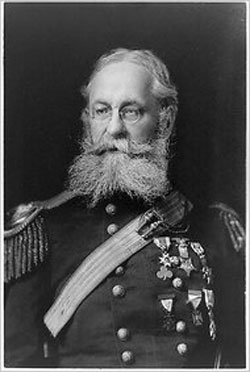 |
"The ancient and beautiful seaport of Newburyport, where I was born March 27, 1844, was the birthplace and life residence of my father, John Balch Greely. The great fire of 1811 swept away the considerable accumulated wealth of my grandfather, and obliged him to become a shoemaker. My father was brought up to this trade, in which he was expert as shoe cutter, cobbler and shoemaker. His education was that of the common schools only, but he supplemented that excellent foundation by much reading. His favorite volumes were the Bible and Shakespeare. Bancroft, Irving and Macauley covered his historical library. For fiction he went to Cooper and Scott. Marco Polo had a fascination for him, and travels. Religiously trained, he gave special attention to such subjects, which turned him to liberal faith. He thus became familiar with the writings of Channing, Carlyle, Emerson and Martineau.
"With his cultured nature and scholarly tastes my father became a man of standing in the literacy circles which then were found all through the section. His liberal development along religious lines was shown by his forming, with four others, the First Universalist Church in Newburyport (on the corner of Fair and Middle Streets) - an act which brought him into active disfavor with his former orthodox associates. Living modestly by the labor of his hands, he never sought public office, though he was always active in matters of general interest, and never failed to vote."

|
Georgiana Bassett
Georgiana Bassett (1850-1939), author of A Child's Recollections of Newburyport 1850-1865, written in 1930, lived at 10 Court Street, which runs parallel to the Immaculate Conception Catholic Church parking lot. Here Ms. Bassett recalls the beautiful gardens at her home:
"Our garden was a great joy to me always. It was small compared with some of the beautiful gardens on High Street but it was full of fruits and flowers with a box bordered walk down the center. The flower beds on each side held many old-fashioned flowers, mostly perennials. Just back of the box border was a row of polyanthus, an old-fashioned spring flower. There were also many spring bulbs of the common variety such as crocuses, daffodils, hyacinths and tulips.
"The summer flowers were roses, larkspurs, and lilies. A large bed of lilies of the valley were a great joy to me. They were of a smaller variety than those which we have now, but equally sweet smelling. For many years they blossomed profusely; they seemed to die out and travelled to another part of the garden, which seemed very curious to me.
"The roses that I remember the best were the moss roses (portulaca), yellow roses and blush roses, also a scentless variety of a climbing rose called the ‘Prairie Rose’ which climbed over the front of the house, but was not as interesting to me as the white honeysuckle and red honeysuckle which climbed over a trellis on each side of the front door.
"The pink moss rose bush in the garden is still alive. It is very sweet scented and they tell me is not a rose that is sold by florists now. Within the last three or four years I have given away four roots that are all doing well. The blush rose was very beautiful and very fragrant. That has died out, and I think, is not carried by the florists now.
"We had then, evening primroses. They grew on tall stalks with many small yellow flowers on top. The little single, yellow flowers which were very fragrant opened suddenly at just sunset. It was a pleasure for the children then and many years after to have what we called ‘Primrose parties’, and to go out to the garden at sunset to see them open. The primroses have died out, and I have several times tried to replace them, but did not find any.
"The garden was well filled with fruit. A large grape-vine climbed to the top of the house on the brick wall. I used to think when the grapes were ripe that it was great fun to jump out of bed and pick a bunch early in the morning. Also whatever cat had possession of the house at the time liked to climb up the trellis to which the grape-vine was fastened and tap, tap, tap, at the window until she was let in. That took some courage to do, if it were a stormy night, but it had to be done for the tapping went on until the cat was safely on my bed."

Frederick T. Somerby
In 1852, Frederick T. Somerby (1814-1871), author of Hits and Dashes: or, A Medley of Sketches and Scraps, Touching People and Things, writes of Timothy Dexter (1748-1806):
Portrait of Timothy Dexter by Philip Kappel, Timothy Dexter Revisited.
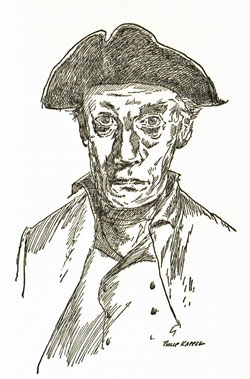 |
"Of course, you and the whole world have heard of Lord Timothy Dexter, who so pompously flourished here some thirty or forty years ago. But whilst all his little foolish eccentricities have been published to the world, I am sorry to say that his many virtues have been hid under a bushel. He was a benefactor to the people - not party. He took things in a cosmopolitan light - not one-sided. He did not give a large sum to a sectarian minister manufactory; if he had, his name, like some others, would have pealed forth throughout the land. But he gave his little here - his little there. He gave, as a saint, a pretty little purse towards building St. Paul’s church there, which, in olden time, would have canonized him. He gave, as a Christian and a MAN, a goodly sum to be put in the care of the town, the interest of which, annually, to be invested in provisions for the poor, who kept themselves out of the almshouse. In short, he did many noble things, which he should be credited for, and which are now lost sight of through his peculiarities. Everyone who has read his will was no fool, either, as many an anecdote of him will show. Speaking of a man whom he had befriended many times, and got repaid with ingratitude, he said, “D--n him, he reminds me of a hog under a tree, eating acorns, never once thinking of looking up to see where they come from!"

|
Sarah Smith Emery
The Reverend Charles W. Milton (1767-1837) was born in London, England. At the invitation of Reverend John Murray of the First Presbyterian Church, known as the Old South Church, Reverend Milton arrived in Newburyport in 1791 to assist with the local ministry. Dissenters from Mr. Murray’s Federal Street Church enjoyed the young preacher, and a new society was incorporated, "Fourth Religious Society in Newburyport." Reverend Milton took charge, holding meetings at the residence of Mr. Anthony Morse on Milk Street until the meeting house on Prospect Street was completed. Mr. Milton was installed as pastor on March 20, 1794.
In Reminiscences of a nonagenarian, published in 1879 by Sarah Smith Emery (1787-1879), she writes of her memories of attending services at the Prospect Street Church:
"I was about fourteen years of age when I first heard Parson Milton preach; he was in the pulpit when I entered the meeting-house. In those days the seats, which were on hinges, were raised during the prayer, in order that the worshippers might stand more conveniently. As the congregation rose, up went the seats with a clap, and the ‘amen’ was followed by a slam, bang, which rattled the windows and reverberated through the building in a most anti-reverential manner.
Prospect Street Church on the corner of Prospect and Fair Streets. Courtesy of the Newburyport Public Library Archival Center.
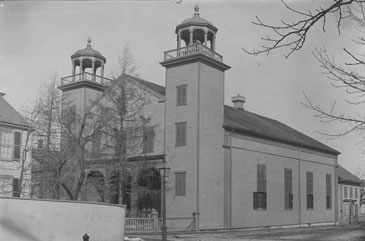 |
"I had scarcely become seated when up jumped Parson Milton from the pulpit, in his gown and bands, like a jumping jack out of a box, and, with up-raised hands, gleaming eyes, the thick curls falling to his shoulders, in quick, curt tones, he shouted, ‘Let’s pray’. Up jumped the congregation; slap! went up the seats. I was scarcely on my feet, or had regained the breath which had been fairly taken from me, when ‘amen’ was pronounced; down, bang! went the seats, and a hymn was given out. I was only too glad, as the pew doors were flung wide and the men and boys clattered down the aisle, to follow them into the winter sunshine of the quiet street."

Alfred Osgood
In Captains, Clams, and Cobblestones, published in 1977 by the Historical Society of Old Newbury, Mr. Alfred Osgood (d. 1899), in a late 1800s paper written for the Historical Society of Old Newbury, reminiscences about meeting General Marquis de Lafayette in the Prince home, later and still today the home of the Newburyport Public Library:
Portrait of General Marquis de Lafayette. Wikipedia image.
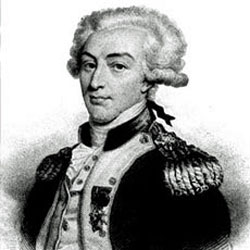 |
"One of the most interesting events, in my estimation, was the visit of General Lafayette in 1824. He arrived here in the evening during a heavy downpour and was received at the Prince Mansion by a drenched and bedraggled multitude, unwilling almost that he should retire though the hour was very late. At sunrise the next morning he was aroused by the over-zealous manifestation of patriotism, etc. by an old drummer of the War of 1812 who for half an hour beat the reveille on his drum. On account of the limited time allotted to his visit, he breakfasted early, it being furnished from the Hotel of John Stetson on the upper corner of Temple Street where now is the grocery of Mr. Phillip Blumpey.
Tracy Mansion on State Street, 1869, then and still the Newburyport Public Library. Luther Dame photograph. Courtesy of the Newburyport Public Library Archival Center.
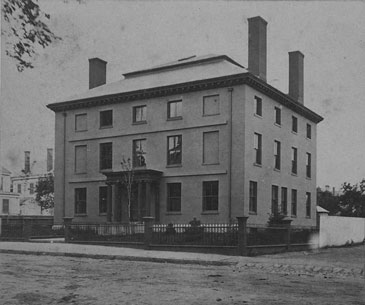 |
"The shaking of hands with the General commenced before nine o’clock, myself being one of the first, passing in at the front door and out at a door (now discontinued) round the easterly corner. Meeting a companion who dared me go round again, I, presuming on my small size and having no fear of Dicky Truesdale, the constable on duty, squeezed through and took the General by the hand again. I also went in behind the crowd that followed Daniel Foster and saw him embraced by the General and saluted as ‘Comrade Major Fostaire.’ A grand dinner was prepared by the citizens, to be enjoyed after a parade through the decorated streets, but the High Sheriff Harris in whose care was the noble visitor, turned on High Street and drove fast for Portsmouth. The citizens enjoyed the dinner, and a toast was given: If Lafayette visits us again, ‘we hope he won’t be harassed!’
"John Stetson who kept the Hotel on the corner of Temple Street, was the father of Charles Stetson, the famous landlord of the Tremont House in Boston and, afterwards, of the Astor House in New York. He took for a wife the eldest daughter of Captain Moses Brown of Newburyport."

|
E. Vale Smith
Author Mrs. E. Vale Smith (1817-1904) in her book, History of Newburyport, published in 1854, describes Plum Island:
"There is no native of Newburyport, and scarcely a stranger who has visited our city in the summer season, who does not retain vivid recollections of this fantastic strip of sand. To the minds of most, its associations are of the social gatherings of friends, of sea-side picnics with home companions and stranger guests; the eye recalls the sand beach dotted with tents; the cloth spread on the clean yellow sand, surrounded with groups of young men and maidens, old men and children, the complacent pastor and the grave deacon, all enjoying together a day of unrestrained mirth and healthful recreation; some indulging in the exuberance of their wild delight amid the waves that roll their white crests to the feet of the more timid watchers, and others preparing the gondola for a return home, knocking away the poles that support the tents, or packing up the fragments of the feast preparatory to stowing them in the carriage, wagon or boat, that is waiting to carry the party home, just as the sun is setting behind the western hills."

Charles I. Pettingell
In Captains, Clams and Cobblestones, published by the Historical Society of Old Newbury in 1977, Charles I. Pettingill’s 1905 reminiscences about a Bromfield Street neighbor, Candy Brown (1832-1908) are included. The time period was the 1860s and 1870s.
"My youth was colored and influenced by personal contact with an unusual character who remains prominent in my memory as he must in that of countless others of my age. He lived directly across from our house on Bromfield Street, and in part of his dwelling he manufactured candy, the likes of which cannot be found today. ‘Candy Brown’ he was called, a hard-working, close-figuring, obstinate individual, who undoubtedly was considered an odd stick chiefly because he had ideas of his own and was consistently loyal to them.
Lower Bromfield Street looking towards Water Street. Courtesy of the Newburyport Public Library Archival Center.
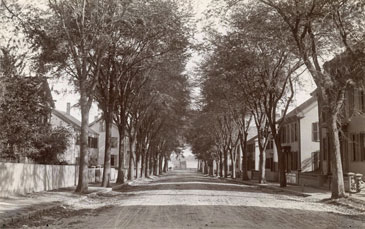 |
"He lived in half a house, that strange New England custom where a house is halved through the middle and each side of the median line is a separate and distinct residence complete in every particular, and yet without a fire wall or any other central division except the ordinary lath and plaster partition. Sometimes, as in Candy Brown’s case, one owner can never agree with the other owner regarding paint, either as to its color or the time of application. He had a love of heavy, somber effects, and the dark red which he favored contrasted prominently with the light green of the other side. It was an interesting sight to see the painters determine the central line of the house; with meticulous care they chalked it down the entire front of the building, then their most skillful craftsman carefully drew in the line as it crossed each clapboard, after which the others brushed with less care up to this fixed terminus. And in doing this work, no staging might hang from the roof of the other owner nor ladder rest against his tenement.
"There was constant warfare between Mr. Brown and the boys of the neighborhood. My relations with him were such that I never participated in any of the attempts to harass him, and I used to think that he would have been harmless if he had been left alone, but he and his cat and his dog were regular objects of attack. His retaliation was to prevent all games in the street near his residence, to forbid any loitering near his premises, to destroy all slides in winter by dumping ashes on them, and to confiscate all youthful property upon which he could get his hands. Woe to the owner of any baseball that strayed into his driveway! It was never seen again."

|
|
|

 Copyright © 2012, Newburyport Clipper Heritage Trail. All rights reserved.
Copyright © 2012, Newburyport Clipper Heritage Trail. All rights reserved.

 Copyright © 2012, Newburyport Clipper Heritage Trail. All rights reserved.
Copyright © 2012, Newburyport Clipper Heritage Trail. All rights reserved.